“It’s not heavy enough for you to hurt yourself. Go for it.”
I heaved, exploded, and grunted as I did my best attempt at a weight lift called a 'snatch.'
It wasn’t pretty, but it established a baseline for my coach so he could pick the best ways to help me improve.
The snatch is a technically complex movement starting with weights on the ground. Through a series of much smaller movements, the weights end up overhead.

A professional snatch made to look oh so easy...
I could watch all the YouTube tutorials I wanted, but without actually attempting a snatch myself, it’s hard to know my baseline—what parts of the snatch I was already decent at, and what parts needed focus.
Of course, the trick is to make sure you don't hurt yourself when you're finding out your baseline...
Facebook advertising is a complex paid-traffic strategy. Through a series of smaller strategies, you publish your first ad and use it to establish a baseline to see where you need to focus so you can ultimately improve your online business.
And like the snatch, when establishing your baseline with Facebook advertising, your goal is to do it...without hurting yourself your wallet.
If you’ve been wanting to try Facebook ads for your business (or already tried), you might have needed help answering these questions…
More...
This post will answer all of these questions. It will give you a game plan to establish your baseline so you know exactly where you stand. I will also show you how to identify where you can improve your ads and ad funnel so you can be successful with Facebook ads for your online business.
By the end of the post, your first ad will be published, your baseline numbers established, and you’ll understand enough of the little idiosyncrasies of the Facebook ads manager to confidently publish more ads to improve upon your baseline.
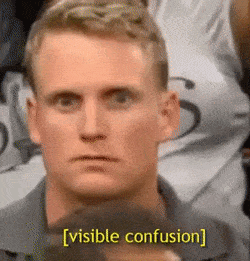
Go from visible confusion...

...to confident swagger.
The Biggest Mistake You Don’t Want to Make
Before spending money on Facebook ads for your business, you need to make sure when someone clicks on your ad, they get taken through a:
Crucial Tip: Do not ever send Facebook ad traffic to your homepage. If someone clicks your Facebook ad and gets taken to your homepage, then I only have one gif for you…
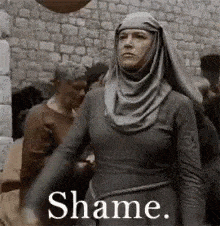
Please follow this crucial tip.
Let’s break each of these pieces down, so there’s zero confusion.
Dedicated - the only traffic seeing the funnel is traffic from Facebook. If you already have a funnel getting traffic from other places, make a copy to use exclusively with your Facebook ad traffic.
Functioning - your funnel needs to work, technically. It doesn’t matter how beautiful or smart the page is if it doesn’t do what it says it’s going to do. Wouldn't it be a pity to send visitors to a lead generation page only to notice $100 later the lead form wasn't connected to your email provider?
Funnel - You need a simple funnel consisting of a landing page and a thank you page. A landing page has one purpose: convert a visitor for a specific goal.
For the purposes of this post the specific goal should be lead generation. This means a visitor to your landing page should have three options and only three options: convert (become a lead), close the page or read your disclaimer/privacy policy/terms and conditions.
There should be no links to your homepage, social media profiles or blog posts. If the visitor converts, they should be redirected to a thank you page.
Offer ONE Thing - This is something you’re giving away for free in exchange for contact info, like an email address. This can be a free report, checklist, guide, course, consulting call, but should NEVER be “Sign Up for My Free Newsletter.”
If you do not have a dedicated, functioning funnel offering one thing to the people who click your Facebook ad...do not pass go, do not collect $200.
If you’re not quite there yet, here’s some resources to help you pass go and collect $200:
Have a Product to Sell?
Yes, your “offer” can be your product and your landing page can be the sales page for the product. However, I don’t recommend this strategy for your first ad attempt as it takes longer to get conversions and therefore, longer (and more money) to figure out your benchmark.
Further, this post only discusses a ‘cold traffic’ ad (people who have never heard of you), which can be tricky to convert as you’re asking for money.
Make Your First Ad in an Afternoon
You will be building a photo ad to display in the Facebook Newsfeed for desktop devices. They are clean, simple and effective.
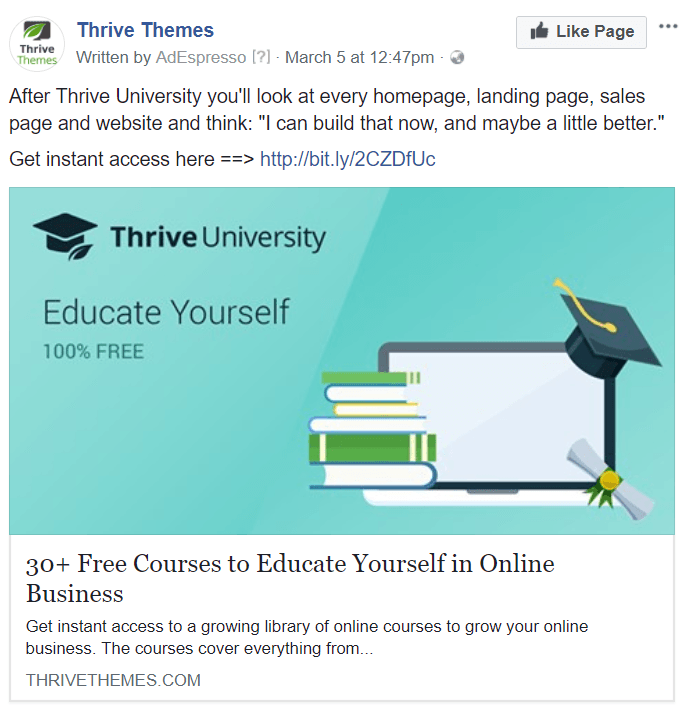
Photo ad to display in the Facebook Newsfeed for desktop devices.
Facebook has MANY other ad formats to choose from: canvas, carousel, video, sidebar, slideshow, mobile, collection, messenger…
Do not worry about them for now. They are something you can experiment with later on.
The Four Parts You Need
There are four parts to a Photo Ad showing in the Facebook Newsfeed on desktop devices:
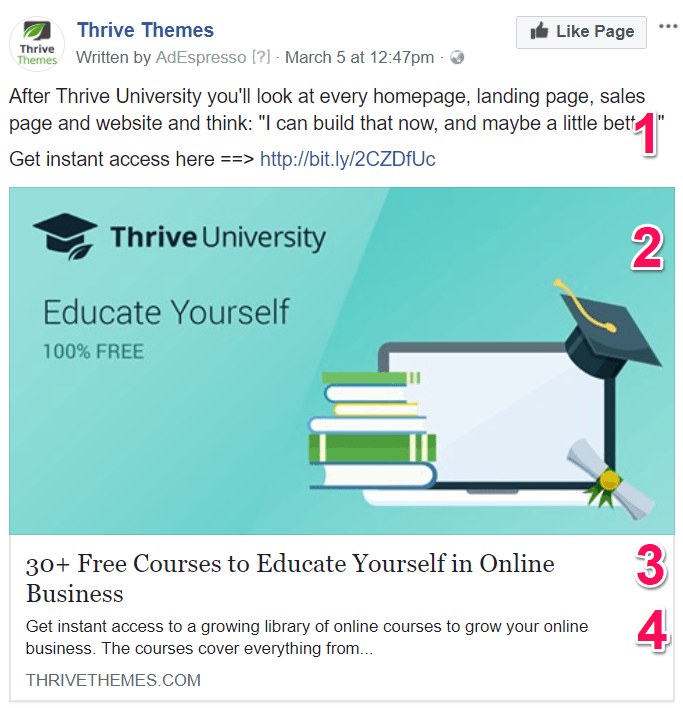
The four parts you need to create.
- 1The Ad Text
- 2The Image
- 3The Headline
- 4The Description
Remember the landing page you already need to have built? You’re going to use it come up with the four parts.
You want the ad and landing page to be similar. This will increase the congruence between the two, which is (generally) a good thing.
This is what the landing page for the ad above looks like:
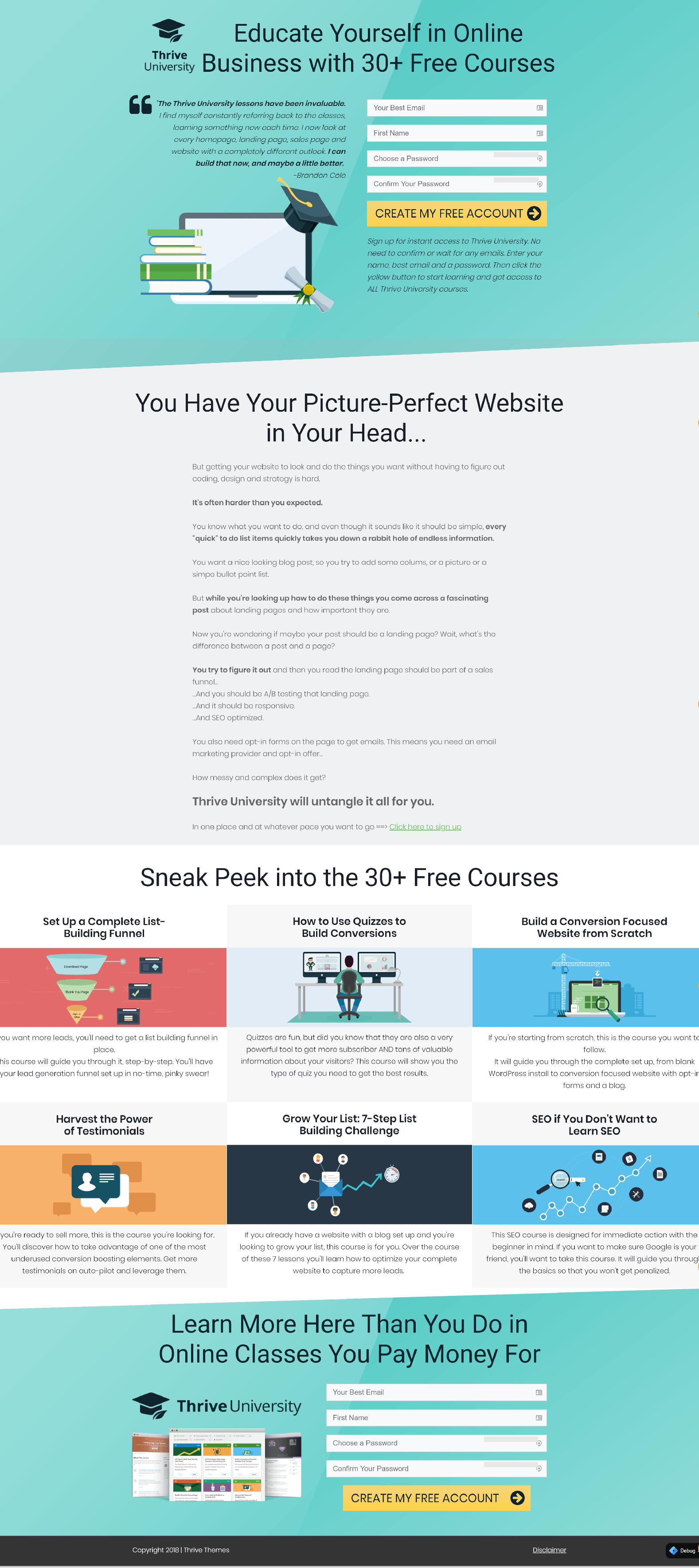
Notice all of the similarities? Same color, image, headline, testimonial...
Guidelines for Your First Ad
Now I can already hear the questions piling up:
The answers to these questions are not helpful, but I’ll give them to you anyway: 1) It depends and 2) It doesn’t matter right now.
If you’re struggling or feeling indecisive, I’ll give you advice along the same line as my weightlifting coach:
Spend no more than a few hours coming up with the 4 ad parts based on your landing page and then go for it, you’re not going to hurt yourself.
Congratulations! You have your first ad ready to be published. You'll be able to see what it looks like before you publish later on in the process. So hold tight, before we get to publishing, let’s set up the behind the scenes stuff to give you the edge you need to be successful.
Get Your Tracking Ready Now So You’re Not Guessing Later
To track the performance of your ad you need to have the Facebook pixel installed across your entire website and the thank you page of your offer needs to be defined as a successful conversion.
This will allow you to gather all of the numbers you need to establish your baseline and find where you can improve.
Before you can get a pixel, you need:
Step 1) Acquire Facebook Pixel
To set up your pixel, go to your Pixels tab in Events Manager, click “Create a Pixel,” and follow the wizard.
What is the Facebook Pixel?
It’s a piece of code for tracking.
When a Facebook user visits your website, the pixel tracks what they did on your website so you can make better ads. Facebook offers a bit of reporting, but it’s not like Google Analytics, and the Pixel doesn’t allow you any access to the personal Facebook profile information of anyone.
Step 2) Install Pixel Across Your Entire Website
Copy your pixel code from step 1 and install it in the header of your website.
If you’re using a Thrive Themes’ Theme: Go to your WordPress admin dashboard and click on the Thrive Dashboard. Look for the Thrive theme (the name of the theme you have chosen) and click on the green “Theme Options” button.
Now, from the “General Settings” section, you will have to select “Analytics / Scripts” and paste the Facebook Pixel code into the “Header Script” field.

Where to paste your Facebook Pixel code if you're using a Thrive Themes' Theme.
Attention Thrive Architect Users
Our landing pages strip all code from your Theme.
So, if you’re using Thrive Architect for your landing pages, you need to follow this tutorial (in addition to the step above) to make sure your pixel gets installed on all of your current and future landing pages.
Step 3) Track Your Conversions
This is why you need a thank you page. You need to install a specific piece of Facebook code on this page to alert Facebook when your ad succeeds in converting someone who clicked your ad.
Standard Events Tracking Vs. Custom Events Tracking
There are two different ways to track conversions with the Facebook Pixel: event tracking—what I recommend you use—and custom conversions, which is what you might have used if you've attempted Facebook ads already.
The only advantage to custom conversions is they are slightly easier to set up.
The two major disadvantages to using them:
- 1You can only create 100 custom conversions for your pixel (event tracking is unlimited). While this will be enough for most, if you get hardcore about Facebook ads and if your business grows, 100 will not be enough. Changing your tracking at this point will make you sad.
- 2Custom conversions can be less accurate than event tracking as there's more room for error. For example, you could build a custom conversion from a URL containing "thankyou", thinking this will only match mywebsite.com/order/thankyou. However, there could be a product page at mywebsite.com/products/thankyou-notes, meaning you'll get inaccurate numbers. By using event tracking, you'll avoid these types of errors.
Follow step three of this guide with the notes below to generate the code snippet you need.
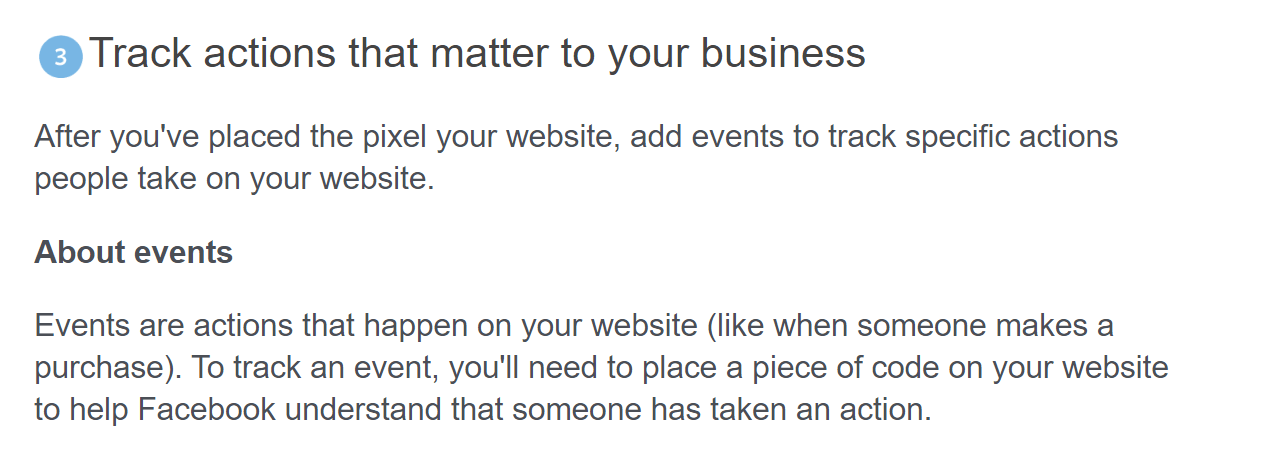
Start here (after clicking the link above) to generate your code snippet.
Notes About Generating & Installing The Code Snippet
Step 4) Testing Your Pixel Installation
To test to make sure it’s all set up correctly, install the Facebook Pixel Helper Chrome Extension and then visit a few random pages of your website and check to make sure your pixel is working (you should see the pixel is found without errors in the Facebook Pixel Helper extension).
Do this again on the landing page you’ll be sending ad traffic to.
Finally, load up your thank you page and check the Chrome Extension to make sure the ‘Lead’ event is being triggered.
If you’re encountering issues, you can troubleshoot using this documentation.
Beautiful! Now you’re all set up to gather data on your ad's performance so you know exactly how well it does and how you can improve the funnel going forward.
Now, let’s work on your ad targeting to make sure you’re showing your ad to the best possible people.
Don’t Waste Money, Target the Right People
Showing your ad to people who aren’t ever going to be interested in what you’re offering is a waste of money.
So let’s not do that. Here’s how...
There are the 3 scenarios you could find yourself in at this stage (in order of best to you’re-still-not-going-to-hurt-yourself):
Scenario 1) You Had the Pixel Installed Across Your Website Before Reading This Post
Your targeting will be easy to set up in this case, because all you need to do is create a ‘Lookalike’ audience.
Basically, you let Facebook’s algorithm do the heavy lifting. You say “Hey, Facebook algorithm, find people who are similar to X so I can show my ad to them!”
And Facebook’s algorithm says “Say no more, I got this.” and it spits out a Lookalike audience similar to X you can use to show your ads to.
The key for you, is what ‘X’ is and how many you can give the Facebook algorithm to build the Lookalike audience from.
You need at least 100 to create a lookalike audience, and you want to choose the X’s as close to your conversion goal as possible. For example, you could create a lookalike from 3 possible X’s:
- 1People who have been to your website.
- 2People who have seen the landing page for your offer.
- 3People who have seen the thank you page for your offer (i.e. they reached the conversion goal).
Facebook calls these X’s “Custom Audiences.”
How to Create a Custom Audience
Before you can create the Lookalike Audience you need to create the Custom Audiences from website traffic. To create a Custom audience from website traffic:
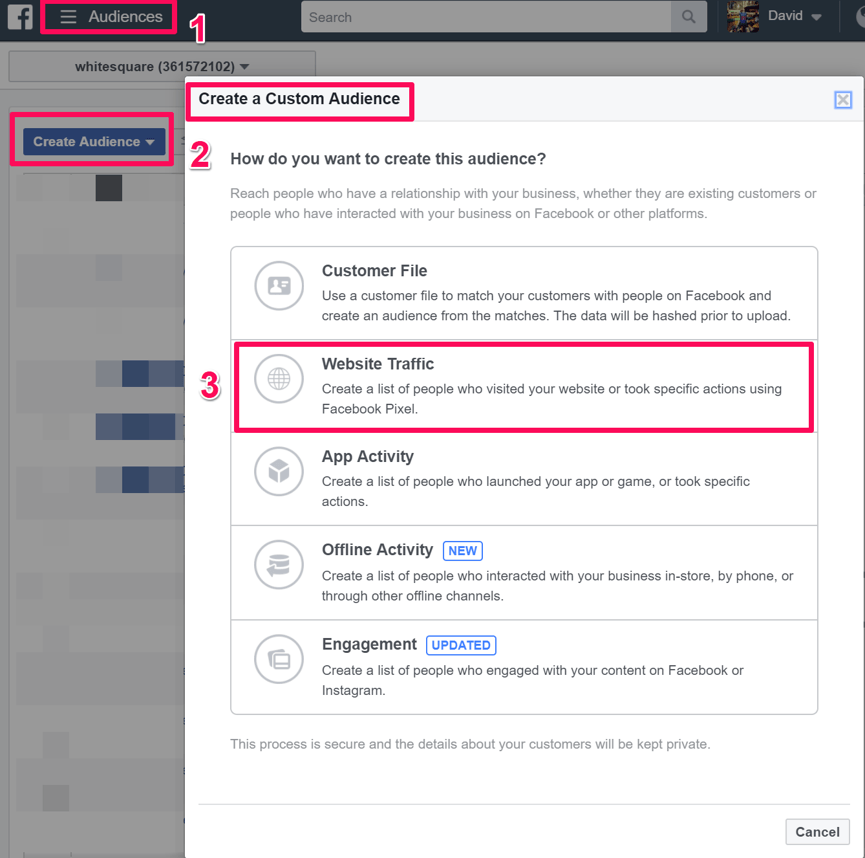
How to create a Custom Audience from Website Traffic.
- 1Go to your Audiences Page.
- 2Select ‘Create Audience’ and then ‘Create a Custom Audience.'
- 3Select ‘Website Traffic.’
Now you need to use your website URLs to create a ‘Custom Audience’ for each of the three audiences I listed above:
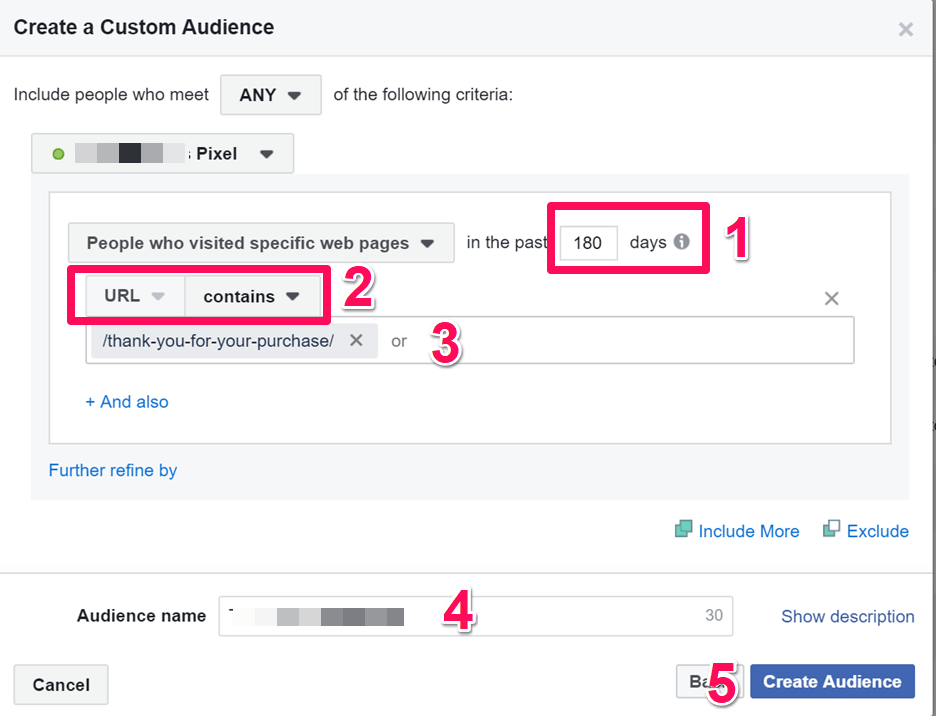
How to create a Custom Audience from Website Traffic.
- 1Set to 180 (the maximum amount).
- 2Set to ‘URL’ and ‘contains.’
- 3Use your website URLs for each of the three audiences:
- People who have been to your website: “www.[yourwebsite].com”
- People who have seen the landing page for your offer: “/landing-page-for-your-offer/”
- People who have seen the thank you page for your offer: “/landing-page-for-your-offer/thank-you/” - 4Name the audience.
- 5Click ‘Create Audience.’
You should now have three custom audiences. These will take a few hours to populate.
How to Create a Lookalike Audience
Once they have populated, you can create 3 Lookalike audiences. 1 from each of them (as long as they are larger than 100).
- 1Go to your Audiences Page.
- 2Click ‘Create Audience’ and select ‘Lookalike Audience.'
- 3Choose your source. This is where you select one of the custom audiences you created in the last step.
- 4Select the country/countries where you’d like to find a similar set of people.
- 5Choose your desired audience size with the slider. Choose 1% here.
- 6Click 'Create Audience.'
Wait for them to populate and boom! You now have between 1 & 3 audiences to target for your ad!
How Accurate are Lookalike Audiences, Really?
Facebook collects a massive amount of data about its users. In 2015 Dr. Michal Kosinski released this study, which proved an algorithm could evaluate a person better than their colleagues based on 10 Facebook “likes.”
150 “likes” and the algorithm surpassed what the person’s parents knew. After 300 “likes” the algorithm understood the person better than their partner. And of course, the more likes (plus all the other data Facebook collects), the better it understands…
So to answer the question: lookalike audiences are creepily accurate.Scenario 2) You Have an Email List Over 100 People
For this scenario you’ll create a Facebook custom audience from your email list and then create a lookalike audience from this custom audience.
Step 1 - Export your list to a .txt or .csv file from your email service provider (MailChimp, ActiveCampain, etc.). Each one is different so google “Export list + [your email service provider]” and a tutorial for how to do it will pop up for you to follow.
Step 2 - Create a custom audience from the file. Follow the steps outlined above, but select ‘Customer File’ instead of ‘Website Traffic’ for the third step and then follow this guide to upload your list correctly.
Step 3 - Use the custom audience to create a Lookalike audience. Follow the steps outlined above, and choose your email list custom audience as the source.
Scenario 3) None of the Above
Don’t worry, all is not lost if you find yourself here.
You will need to do some research and then use tools provided by Facebook to create your own audience to target.
You can follow the strategy outlined in our post: Steal Our Facebook Targeting Hack to Jumpstart Your Online Business.
Congrats! No matter what scenario you found yourself in, you should now have an audience ready. This is who will be seeing your ad once it’s published.
Publishing Your Ad
And now the moment we’ve all been waiting for, publishing your ad!
We’ll be using the Facebook Ad Creation wizard. So click here if you’re ready to get started.
Because we’re only publishing one ad, this will be very straightforward. However, you can find a more in depth explanation on campaigns, ad sets and ads at the end of this section.
- 1Select ‘Conversions’ as your marketing objective, give your campaign a name and hit continue. You don’t need to worry about any of the other options.
- 2Now you’re at the ad set level. Give your ad set a name and proceed to the conversion section.
- 3In the "Get Your Tracking Ready So You’re Not Guessing Later" section of this post you prepared a bit of code for your thank you page. This is why. Now you can optimize your ads for specific conversion events. Select your conversion event as ‘Lead’ from the drop down and Facebook will optimize who it shows your ad to based on this conversion goal. Remember, they are creepy good at this.
- 4Now you select your audience.
- If you’re using a lookalike audience (Scenario 1 & 2), click the ‘Custom Audiences’ box and select the Lookalike Audience you want to use from the drop-down.
- If you’re using an audience you created with Facebook tools (Scenario 3), click ‘Use a Saved Audience’ and find the audience you saved from the list. - 5Now to select your placement. Click ‘Edit Placement’ and make sure only ‘Desktop’ is selected for Device Types.
- 6For platform selection make sure the only box checked is ‘Feeds’ under Facebook. Un-check everything else.
- 7For Budget & Schedule set a Daily Budget of $10.00 and check ‘Run my ad set continuously starting today.’
- 8There’s an advanced options section. Just double check that ‘Conversions’ is set for Optimization for Ad Delivery. Everything else can be left on the Facebook default settings. Now hit Continue to move to the Ad.
- 9Give your ad a name and select your Facebook Page for the identity.
- 10Select ‘Single Image’ for format.
- 11Upload the ad image you created.
- 12Make sure ‘Website’ is selected for link type.
- 13Add your Ad Text in the ‘Text’ box. This is the text that will appear above the ad image.
- 14Add the link to your landing page in the website URL box. You can use UTM parameters for your link if you use Google Analytics, otherwise the plain URL is fine.
- 15Add the Headline you came up with.
- 16Select a call to action button, if you’d like. I recommend ‘No Button.’
- 17Click Advanced options and add your description (the text under the headline) in the ‘News Feed Link Description’ box.
- 18Give everything a look over and if you’re happy with it. Hit Confirm. Your ad will then go into review, and once it’s accepted it will be shown to your audience!
If your ad is rejected, there could be many reasons. Facebook won’t tell you the exact reason, but this post outlines why it might have been rejected.
Campaigns, Ad Sets & Ads, Oh My!
This is the structure Facebook uses to help you organize, optimize and measure the performance of your ads.
Within a single campaign you can have multiple (or 1) ad sets and within an ad set you can have multiple (or 1) ads.
At the campaign level you determine your objective. For example: generating leads for your website vs. increasing engagement on your Facebook page. As we continue, let’s pick generating leads as our objective.
At the ad set level you determine targeting, budget, schedule, bidding and placement. For example, you could have two different ad sets, which are both trying to generate leads. One ad set could be targeting Women ages 18-25 and the other ad set could be targeting Men ages 55-65.
As your campaign is running, one ad set might perform better than the other, and now you can make adjustments to one ad set and not the other, like increasing the budget of the ad set doing well. As we continue, let’s pick the Women ages 18-25 ad set.
At the ad level you determine what’s being shown to the audience. For example, in our Women ad set we could have one ad with a picture of our opt-in offer and one ad with a picture of a family laughing.
As the campaign is running we see the picture with our opt-in offer results in more leads, so we pause the ad with the picture of the family laughing.
How Much Your Baseline Will Cost
Let your ad run for a week. This will cost you $70.
After the week is done, press pause on your ad so you can start understanding the numbers and evaluating your funnel. The numbers you’re interested in are:
You can find all of these numbers in your ads manager except the website conversion rate. You can calculate it with this formula: (Landing Page Views/Website Leads) x 100.
The easiest way to find them in the ads manager is to create a customized set of columns. You can read this documentation on how to do it.
Here’s what it will look like before you save it:
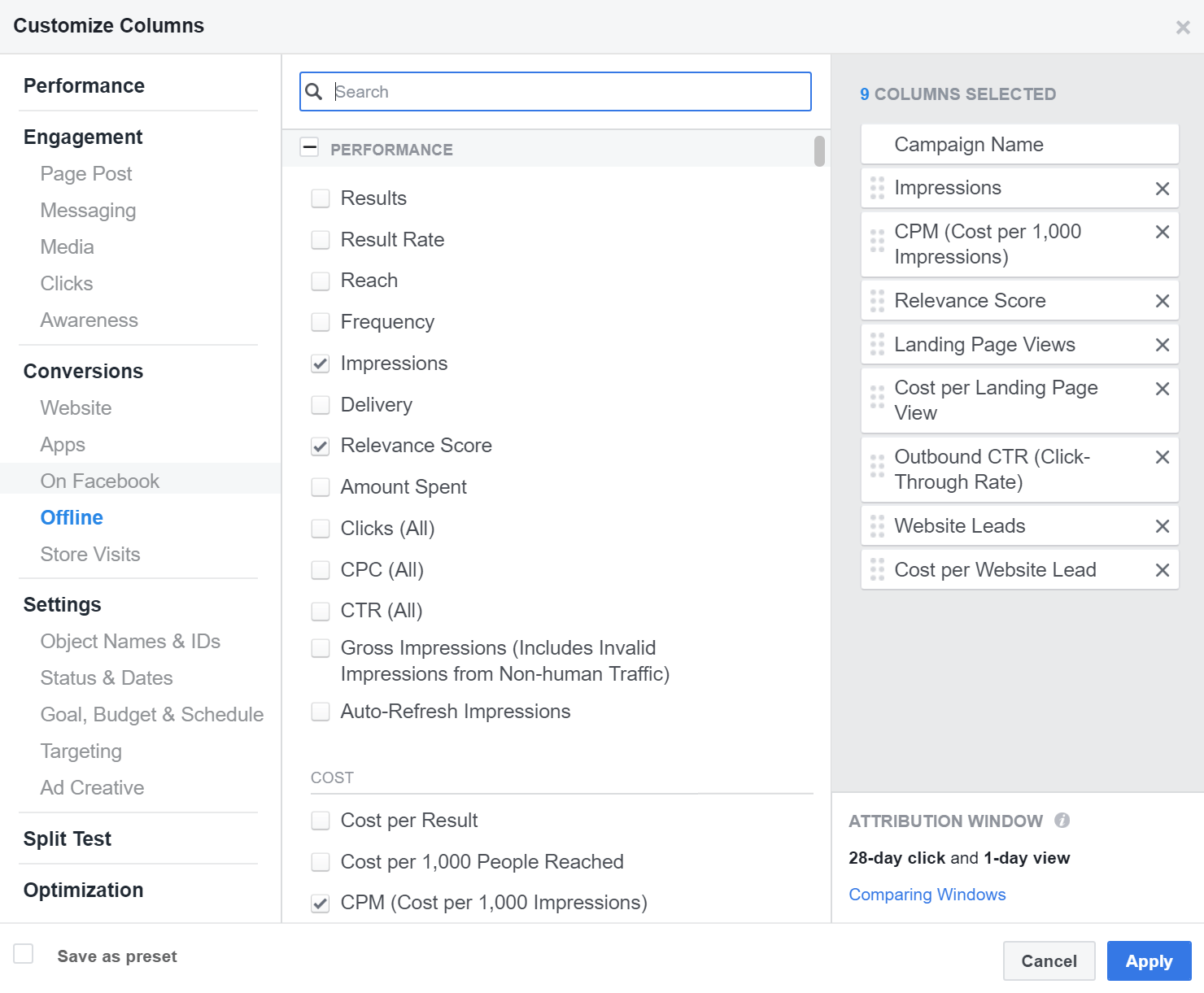
Customizing your reporting columns to get the numbers you need.
Now you have a rough* baseline of your numbers and you can use them to improve. In your next attempt you’ll be looking to increase your Outbound CTR and Website Conversion Rate and/or decrease your cost per landing page view and Cost per Website Lead.
*I say ‘rough’ because some of these numbers might not be statistically significant yet, especially your website conversion rate. For a more in depth explanation on this, including how to find out if a result is significant, check out this post on A/B testing with low traffic.
Next Steps for Improvement
Now, let’s figure out the best place for you to improve your funnel with this quick check. Look at the ratio of Impressions to Landing Page Views and then the ratio of Landing Page Views to Leads.
These should be about 3:1*. Meaning for every 9 people who see your ad, 3 should click and check out your landing page, and 1 person of those 3 should convert.
Generally speaking, the best place to do better is on your landing page as it’s the closest point to your conversion goal.
Start with the basics:
Then make your landing page even better with these 5 Ways to Take Your Conversion Rates to the Next Level.
Once you’ve done these you can start A/B testing your landing page using Thrive Optimize and you can use our A/B Testing Quickstart Toolkit to learn everything you need to know.
Now you can start trying to improve your ad. The best skill to learn for this is copywriting. This post discusses 6 brain hacks you can use in your ad and you can take our course on copywriting (this course is only available for active Thrive Suite customers) to take your skills even further!
*3:1 is a good place to start, but it's just a rough baseline as these numbers will vary across what you’re offering, across websites offering the same thing and across different industries. This is why it’s so important for you to establish your baseline in the first place. They are YOUR numbers and your goal then becomes to understand them and then improve.
Go For it! You’re Not Going to Hurt Yourself
All it takes is $70 and you’ll be able to establish your baseline when it comes to Facebook ads.
If you’ve followed this post, you’ll not only have the foundation in place for you to take your ads further, but you’ll know where to focus your energy. So awesome job making it to the end!
Thoughts, questions, celebration of understanding? I will respond to anything you leave in the comments below!





Hey Dave, thank you so much for this comprehensive, well thought through guide. Brilliant.
Glad it was helpful, Mark!
been using fb ads for years, wish I had read this first…!!!
Wish this could have come at a better time, but I’m also glad to know it was still helpful for people who have been running ads for a while!
Am I the only one on the planet that is Super Irritated by animated gifs? To me it detracts and spoils what is a very informative article. I am so irritated by them that I have developed selective blindness for it. PLEASE can everyone just get over this craze.
It sounds like you’ve solved your own problem by developing selective blindness! You don’t have to be super irritated, and the people who enjoy the lightheartedness gifs can bring to a more in-depth topic can also be happy.
Win-win! Thanks for being adaptable, Martha!
Thank You Very Much . This is really very helpful post.
It will be more easy if you add Video along with blog post. But, then again thank you 🙂
I’ll keep the video idea in mind! Glad you found it helpful anyway 🙂
what a good summary 🙂
Thanks for the all in one refresh / checklist article
No problem Damien!
this is the most comprehensive and easy-to-follow guide I’ve read on the subject so far. pure gold! thank you
Knowing it’s easy-to-follow is music to my ears! Thanks Brigid 🙂
Fantastic post Dave! I swear you guys read my mind when writing your posts. 🙂 I was just looking at Ads Manager last night and wondering what the heck all this means. Thanks for the in-depth article. Printing this puppy out.
Glad you enjoyed it Heather, and that it came at the right time! Let us know how the ads go!
This is “The Best” and most comprehensive article written simple enough for a newbie to understand!
Awesome to hear, Chris! Glad you found it easy to understand 🙂
It’s timely written article, at least for me. Looking at so many great comments, I can’t wait to read it 🙂
That’s what I like to hear!
Excellent post, Dave. I am just about to launch our first Facebook ads, so this post came at a perfect time. Thank you!
Glad you found it helpful, Jayne! Let me know how the ads go!
This article is great, thanks to the Author
Glad you found it helpful!
i, thanks for the beautiful article.
I ask a favor, when I click “Take this free email course” that is in the text of the article, comes out a popup, I enter the data and confirm, at this point comes out an error page and does not arrive content via email.
I would be grateful to be able to consult this content
Thank you
Hmm, sorry about that Paolo. I’ve just tested it, but everything seems to be working so I’m not sure what the issue could be. However, I’ve added you to the course manually, so you should be getting the content soon 🙂
Thanks 🙂
Completo y muy instructivo el artículo. Muchas gracias al autor.
Gracias Marcelo!
Way easier to understand than anything Facebook provides on the topic
Haha, that’s what I like to hear!
I haven’t even tried to understand FB ads, I thought I will find sy who can explain it in a human language….just like website building. And indeed, I found the right sources 😉
That’s what I like to hear!
2 questions for this amazingly informative post on fb ads:
1. My website’s focus is more on b2b (I have a podcast for professionals) – would you still consider fb as a good source for paid traffic?
2. I have a list of 2,200+ emails from LinkedIn – can I utilize this for a custom audience? It is not laser targeted and I wonder if method 3 to create an audience is maybe better?
Again, great and amazing post and I’m sooo ready to start fb ads.
Hi Philipp, glad you found the post helpful!
1. Yes, No, Maybe so? Try it. Get some numbers and see 🙂
2. As long as you have access to the emails and can get them into a .csv or .txt file, yes. Not sure which method would be better, so I recommend using them both and then testing to see which one does better.
I should have answered #1 myself *lol* As your post is about testing and establishing a baseline, I may need to read it again (and again).
Thank you for the response, love this article. Will print it out (I’m soooo oldschool) and make heavy use of it 🙂
No problem, Philipp!
great post Dave, looking to expand a lot more into FB ads, finding conversion targeting once data is in is working great, wondering if the course goes into detail on working on best outcomes when its not possible to get any conversion data ? 🙂
Hey Scott, glad you enjoyed the post! Which course are you referring to, and why won’t you have any conversion data?
Article très intéressant ! Merci beaucoup Dave !
Pour moi aussi, ce post arrive juste quand j’en ai besoin.
Bonne continuation.
De rien, ravi que cela ait été utile 🙂
Gosh, this was INCREDIBLY useful and valuable. Thank you SO MUCH Dave <3
I've been extremely overwhelmed by FB Ads since sevearl months, and now you basically removed all my objections and encouraged me to try them out (and I will, because I know I need to).
Again, thanks a lot!
You’re welcome, Maricarmen! Glad you found it useful and valuable. Let me know how it goes 🙂
Hi Dave:
Thanks for this awesome article. This is the best explanation on how to do Facebook advertising I have seen. I will use your suggestions. Thanks again.
Glad you found it helpful!
P.S. – Great name 🙂
Obrigado Dave, obrigado Thrive Themes. Em nenhum outro lugar na internet e nem mesmo em vários cursos que já fiz, eu encontrei tantas informações relevantes como neste post. Foi como se eu estivesse sentado ao seu lado e você me passasse as informações que sempre busquei. Sou realmente fã de vocês.
Feliz foi útil 🙂
Thanks Dave, Awesome info. I am not ready quite yet for Facebook ads. Still trying to nail down building a website then a landing page. But, I am really looking forward to jumping into Facebook ads by Dec. My niche for the Facebook ads will be young families looking for good music for their kids. And we have great original music for young families (Donna & Andy)! Pretty good sized market (world wide) don’t you think? Yeeha! Thanks again!
You’ll be ready for ads soon! Your niche sounds awesome 🙂
Thanks for the insights! I am wondering why you recommend “desktop” to run an ad. These days there seems to be more mobile users than desktop users…
Because this post is about getting your first post out there so you can establish a baseline and learn the ins and outs of the Facebook ads manager and not necessarily about publishing an ad where a majority of the users are.
Once you understand how everything works, of course, experiment with mobile…just make sure your landing page is mobile responsive!
Wow… talk about holding someone’s hand and leading them to a pot of gold! Not only was your content awesome, the step-by-step instruction is brilliant and so easy to follow.
Everyone needs a lil hand-holding (and gold) sometimes. Glad it was helpful and easy to follow 🙂
Nice blog shared! Thanks for sharing it.
Glad you found it helpful!
Great post!! This is the answer
Thanks, Dennis!
Hey Dave,
This was a great article. I’ve been *thinking* about doing ads for years (doing pure SEO based lead generation now), but still haven’t done it. Now I have no excuse anymore=)
But there’s one step missing – that’s the generating income part. By implementing what you wrote, I’ll have leads. But turning those leads into paying customers – where can I learn more about that? I do turn newsletter readers into paying customers now, but I don’t want to pay for lots of leads and just throw them into my newsletter and hope for the best. Any advice?
Thanks,
Oyvind
Hey Oyvind,
Glad you found the article helpful and that now you feel confident to dive into Facebook ads!
Turning your leads into paying customers via email is actually a great strategy as it doesn’t cost you anything extra. Another great strategy is to use Smartlinks, a feature in Thrive Leads allowing you to change all of the opt-in forms on your website to promote your paid products to people who are leads. It’s super powerful and also doesn’t cost you anything extra.
To take the Facebook strategy further, if you’ve followed the advice of this post you’ve set yourself up to start doing retargeting ad campaigns. However, that’s a whole new monster that I can’t tackle in a comment like this.
My advice would be to focus on optimizing your email marketing and conversions on your website to turn all of these leads you just paid for into paying customers so you can see some ROI on your ad spend.
Hope that helps,
Dave
I was not aware of the Smartlinks feature, but sounds awesome. Thanks a lot for the advice, Dave!
Ah man, it’s a game changer! You learn more about it here: https://staging.thrivethemes.com/smartlinks/
Incredible! Thank you. Huge help. How is anyone supposed to figure all that out on their own? You saved us tons of hours and cash.
But if I may give a personal preference note – the gifs were a bit annoying. They have the effect of making me scroll faster through those sections. They were funny but the repetitive nature makes it difficult to read without being distracted- maybe it’s just my ADHD. I assume some people love them so to each his own.
Hey Duke! Glad you found the post helpful and that it saved you time and money!
As for the gifs…there’s another reader, Martha, who gets so annoyed by them she has developed a selective blindness for them! This adaptability allows her to consume content without getting annoyed or distracted. Super cool!
You can find her here in the comments and maybe she can share some tips for how she does it 🙂
Helpful post Dave.
Will help to run a Facebook boost for my new blog in a different way!
Thanks man.
No problem, Cheri! Glad you found it helpful 🙂
Great article! Thanks! As a beginner, I would have thought a 9:1 conversion rate you mention was bad. Now I have one reason less to get disappointed!
9:1 a just a ballpark starting point. Bad or good only matters when it’s your website and your numbers. Good is when you beat your benchmark and create a new benchmark. Bad is when you don’t (although you’ll learn something valuable, so it’s kind of a good thing, too).
OK so forgive the noob Q but where does the small snippet from step 1 of the pixel go – I know it’s ‘At the header of the entire site’ but how do I actually do that?
Are you using a Thrive Theme’s Theme, or something else?
Thrives theme – I have submitted 2 comments this morning (I couldn’t find this one to add to – sorry for spamming up your thread) they are currently in moderation but can be deleted as now irrelevant – Claudiu in support identified that I needed to switch Wordfence to ‘Learning mode’ – problem solved!
My only other question though is – I’m planning on adding several other landing pages, with slightly different forms and ‘Thank you’ pages – in order to track which landing page / route is having most success can I add more event tracking snippets for say ‘Lead 1’ ‘Lead 2’ etc or would I have to employ custom tracking for that?
(I hope that makes sense)
Glad the support team could help solve the problem!
As for your question, I’d only test one new landing page variation at a time so you can be sure what’s working (or not working) and I’d use Thrive Optimize for this. It allows you to create a new page variation, start a test and then switch to the new variation, if it’s a winner, without having to create new Facebook ad campaigns. I’d rely on the reporting in Thrive Optimize to tell you with LP is doing better and not the FB pixel.
And yes, you can add custom parameters to your Lead event so you know which it refers to.
Oh and soon after submitting this original comment I realised how box 1 was just to illustrate WHERE the code goes lol
(Apologies for the spam)
Fantastic post. Thanks!
You’re welcome, Corrie. Glad it was helpful for you 🙂
Dave, this article is packed with golden nuggets and has helped me clarify a lot of things. Thank you. On to my question, why do you suggest to skip the CTA button on the ad? This is a rather contrarian approach to what gurus teach, so it’d be great to understand your reasoning.
The main reason is people don’t share posts as often when they know they are ads. The CTA is a dead giveaway the post is an ad. So when I design my ad I like to try and write it in a way that someone wants to share it as this will extend the ads reach for free.
It’s definitely something you can experiment with though. Add the CTA button and see if your CTR improves (but also check your share count).
Makes sense, Dave. Thank you! will definitely keep it mind.
Awesome article. Enough detail to get you started in the rather overwhelming Facebook ad interface. Just building out my funnel now – using my Thrive membership product line 😉 – and will be using this article as the playbook to set up my first ad. Thanks so much for the article.
Awesome to hear, Matt! Glad you found it helpful!
Hi, very informative article. So, in order to track your conversions, you need to have single opt-in set up instead of double?
Great question, Maria!
You can have both single and double opt-in. For a double opt-in you’d still place your FB lead pixel on the final thank you page as this is still the page that confirms a true lead.
If you want to keep it simple, this is all you have to do. However, you could also use the pixel tracking event called “Complete Registration” on your confirmation page (this is the page where you tell your new subscriber they have to click the confirmation link in the confirmation email). This would allow you to track how many of your leads are failing to confirm their emails.
Hi, Dave, this is a great piece you have dropped here. Thanks for the brilliant work. You rock
Thanks, Nura! Glad you enjoyed it 🙂
As a highly educated person, I found this article incredibly hard to follow. With all the links, I had at least four tabs open at any given time, and had to toggle between them to do this. I eventually just gave up.
Hi Shari, sorry to hear it was hard to follow for you. Although I’ve tried my best to make it as straightforward as possible, Facebook ads anything but straightforward.
Something that has helped me tremendously (I also came from the education world) was to try and not click and read through every link. Links are more for reference to help explain something further if you want to dive deeper on a topic, but they are not crucial to the article itself.
If you have any specific questions though, please let me know and I’ll do my best to answer them for ya!
Well, if it ain’t exactly what I needed. Thanks Dave, will start following this guide. =)
Great article Dave. Would you install the lead event code on the thank you page or on the download page? the real conversion doesn’t happen until the person actually successfully subscribes and gets the download link! Will it matter if they get there via a link from an email?